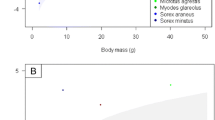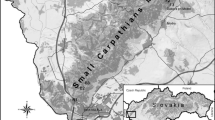Abstract
The distribution and survival of Ixodes scapularis and Amblyomma americanum were studied in deciduous and coniferous wooded habitats and in open habitats on Fire Island, New York, USA. The survival of nymphal I. scapularis in field enclosures was greater in forests than in open habitats, suggesting that greater survival contributes to the higher tick population in the woods. The nymphs of each species were more common in deciduous thickets (predominantly Aronia arbutifolia and Vaccinium corynbosum) than in coniferous woods (mostly Pinus rigida) in most but not all years. Larval I. scapularis were more common in coniferous sites in 1994, while the same ticks, as nymphs, were more common in deciduous sites in 1995. The survival of the nymphs was not consistently greater in either the deciduous or coniferous woods. Therefore, factors other than nymphal survival (e.g. larval overwintering survival and tick movement on hosts) probably influenced the relative nymph abundance in different forest types. Overall, the survival of A. americanum was far higher than that of I. scapularis.
Similar content being viewed by others
References
Adler, G.H., Telford, S.R.III, Wilson, M.L., and Spielman, A. 1992. Vegetation structure influences the burden of immature Ixodes dammini on its main host, Peromyscus leucopus. Parasitology, 105: 105–110.
Anderson, J.F. 1988. Mammalian and avian reservoirs for Borrelia burgdorferi. Ann. NY Acad. Sci., 539: 180–191.
Art H.W., 1976. Ecological studies of the Sunken Forest, Fire Island National Seashore, New York. National Park Service, Scientific Monograph Series 7.
Bertrand, M.R. and Wilson, M.L. 1996. Microlimate-dependent survival of unfed adult Ixodes scapularis (Acari: Ixodidae) in nature: life cycle and study design implications. J. Med. Entomal. 33: 619–627.
Burgdorfer, W. 1975. A review of Rocky Mountain Spotted fever (tick-borne typhus), its agent, and its tick vectors in the United States. J. Med. Entomol. 12: 269–278.
Daniel, M., Honkzakova, E. and Cerny, V. (1972). Overwintering of the tick Ixodes ricinus (L.) under conditions of a field experiment. Folia Parasitol. 19: 305–314.
Dusbábek, F., Daniel, M. and Cerny, V. 1971. Stratification of engorged Ixodes ricinus larvae overwintering in soil. Folia Parasitol. (Praha). 18: 261–266.
Ewing, S.A., Dawson, J.E., Kocan, A.A., Barker, R.W., Warner, C.K., Panciera, R.J., Fox, J.C., Kocan, K.M. and Blouin, E.F. 1995. Experimental transmission of Ehrlichia chaffeensis (Rickettsiales: Ehrlichieae) among white-tailed deer by Amblyomma americanum (Acari: Ixodidae). J. Med. Entomol. 32: 368–374.
Falco, R.C. and Fish, D. 1991. Horizontal movement of Ixodes dammini (Acari: Ixodidae) attracted to carbon-dioxide baited traps. J. Med. Entomol. 28: 726–729.
Fish, D. 1993. Population ecology of Ixodes dammini. In Ecology and environmental management of Lyme disease, H.S.Ginsberg (ed.), pp. 25–42. Rutgers University Press, New Brunswick, NJ.
Ginsberg, H.S. 1992. Ecology and Management of Ticks and Lyme Disease at Fire Island National Seashore and Selected Eastern National Parks. National Park Service Scientific Monograph NPS/NRSUNJ/NRSM-92/20.
Ginsberg, H.S. and Ewing, C.P. 1989. Habitat distribution of Ixodes dammini (Acari: Ixodidae) and Lyme disease spirochetes on Fire Island, New York. J. Med. Entomol. 26: 183–189.
Ginsberg, H.S. and LeBrun, R.A. 1996. Population Regulation, Natural Enemies, and Host-Seeking Patterns, of Deer Ticks, Ixodes scapularis (Acari: Ixodidae). National Park Service Technical Report NPS/NESO-RNR/NRTR/96-02, Boston, MA.
Ginsberg, H.S., Ewing, C.P., O'Connell, A.F.Jr., Bosler, E.M., Daley, J.G. and Sayre, M.W. 1991. Increased population densities of Amblyomma americanum (Acari: Ixodidae) on Long Island, New York. J. Parasitol. 77: 493–495.
Goddard, J. and Norment, B.R. 1986. Spotted fever group rickettsiae in the lone star tick (Acari: Ixodidae). J. Med. Entomol. 23: 465–472.
Hair, J.A. and Bowman, J.L. 1986. Behavioral ecology of Amblyomma americanum (L.). In Morphology, physiology, and behavioral biology of ticks, J.R.Sauer and J.A.Hair (eds), pp. 406–427 Wiley, New York.
Hanrahan, J.P., Benach, J.L., Coleman, J.L., Bosler, E.M., Graham, J.C. and Morse, D.L. 1984. Epidemiologic features of Lyme disease in New York. Yale J. Biol. Med. 57: 643–650.
Koch, H.G. 1984. Survival of the lone star tick, Amblyomma americanum (Acari: Ixodidae), in contrasting habitats and different years in southeastern Oklahoma, USA. J. Med. Entomol. 21: 69–79.
Lockhart, J.M., Davidson, W.R., Stallknecht, D.E. and Dawson, J.E. 1996. Site-specific geographic association between Amblyomma americanum (Acari: Ixodidae) infestations and Ehrlichia chaffeensis-reactive (Rickettsiales: Ehrlichiae) antibodies in white-tailed deer. J. Med. Entomol. 33: 153–158.
Lord, C.C. 1995. Seasonal activity of nymphal Ixodes scapularis (Acari: Ixodidae) in different habitats in New Jersey. J. Med. Entomol. 32: 66–70.
Lord, R.D., Humphreys, J.G., Lord, V.R., McLean, R.G. and Garland, C.L. 1992. Borrelia burgdorferi infection and overwintering in white-footed mice (Peromyscus leucopus) in hemlock (Tsuga canadensis) habitat in Western Pennsylvania. J. Wildl. Dis. 28: 364.
Mather, T.N. 1993. The dynamics of spirochete transmission between ticks and vertebrates. In Ecology and environmental management of Lyme disease, H.S.Ginsberg (ed.), pp. 43–60. Rutgers University Press, New Brunswick, NJ.
Mather, T.N. and Mather, M.E. 1990. Intrinsic competence of three ixodid ticks (Acari) as vectors of the Lyme disease spirochete. J. Med. Entomol. 27: 646–650.
Maupin, G.O., Fish, D., Zultowsky, J., Campos, E.G. and Piesman, J. 1991. Landscape ecology of Lyme disease in a residential area of Westchester County, New York. Am. J. Epidemiol. 133: 1105–1113.
O'Connell, A.F.Jr and Sayre, M.W. 1989. White-tailed deer management study: Fire Island National Seashore. National Park Service, USA.
Oliver, J.H.Jr., Owsley, M.R., Hutcheson, H.J., James, A.M., Chen, C., Irby, W.S., Dotson, E.M. and McLain, D.K. 1993. Conspecificity of the ticks Ixodes scapularis and I. dammini (Acari: Ixodidae). J. Med. Entomol. 30: 54–63.
Ostfeld, R.S., Cepeda, O.M., Hazler, K.R. and Miller, M.C. 1995. Ecology of Lyme disease: habitat associations of ticks (Ixodes scapularis) in a rural landscape. Ecol. Appl. 5: 353–361.
Piesman, J. and Gray, J.S. 1994. Lyme disease/Lyme borreliosis. In Ecological dynamics of tick-borne zoonoses, D.E.Sonenshine and T.N.Mather (eds), pp. 327–350. Oxford University Press, New York.
Rohlf, F.J. and Sokal, R.R. 1981. Statistical Tables, 2nd edn., Freeman and Co., San Francisco, CA.
Schriefer, M.E. and Azad, A.F. 1994. Changing ecology of Rocky Mountain Spotted fever. In Ecological dynamics of tick-borne zoonoses, D. E.Sonenshine and T.N.Mather (eds), pp. 314–326. Oxford University Press, New York.
Schulze, T.L., Bowen, G.S., Bosler, E.M., Lakat, M.F., Parkin, W.E., Altman, R., Ormiston, B.G. and Shisler, J.K. 1984. Amblyomma americanum: a potential vector of Lyme disease in New Jersey. Science 224: 601–603.
Schwartz, B.S., Goldstein, M.D. and Childs, J.E. 1994. Longitudinal study of Borrelia burgdorferi infection in New Jersey outdoor workers, 1988–1991. Am. J. Epidemiol. 139: 504–512.
Semtner, P.J., and Hair, J.A. 1973. The ecology and behavior of the lone star tick (Acarina: Ixodidae) V. Abundance and seasonal distribution in different habitat types. J. Med. Entomol. 10: 618–628.
Semtner, P.J., Howell, D.E. and Hair, J.A. 1971a. The ecology and behavior of the lone star tick (Acarina: Ixodidae) I. The relationship between vegetative habitat type and tick abundance and distribution in Cherokee Co., Oklahoma. J. Med. Entomol. 8: 329–335.
Semtner, P.J., Barke, J.W. and Hair, J.A. 1971b. The ecology and behavior of the lone star tick (Acarina: Ixodidae) II. Activity and survival in different ecological habitats. J. Med. Entomol. 8: 719–725.
Siegel, J.P., Kitron, U. and Bouseman, J.K. 1991. Spatial and temporal distribution of Ixodes dammini (Acari: Ixodidae) in a northwestern Illinois state park. J. Med. Entomol. 28: 101–104.
Sokal, R.R. and Rohlf, F.J. 1981. Biometry, 2nd edn., Freeman and Co., San Francisco, CA.
Sonenshine, D.E., 1993. Biology of Ticks, Vol. 2. Oxford University Press, New York.
Spielman, A., Wilson, M.L., Levine, J.F. and Piesman, J. 1985. Ecology of Ixodes dammini-borne human babesiosis and Lyme disease. Ann. Rev. Entomol. 30: 439–460.
Stalter, R., Lamont, E.E. and Northup, J. 1986. Vegetation of Fire Island, New York. Bull. Torrey Bot. Club 113: 298–306.
Wilson, M.L., 1994. Population ecology of tick vectors: interaction, measurement, and analysis. In Ecological dynamics of tick-borne zoonoses, D.E.Sonenshine and T.N.Mather (eds), pp. 20–44. Oxford University Press, New York.
Wilson, M.L., Ducey, A.M., Litwin, T.S., Gavin, T.A. and Spielman, A. 1990. Microgeographic distribution of immature Ixodes dammini correlated with that of deer. Med. Vet. Entomol. 4: 151–159.
Author information
Authors and Affiliations
Rights and permissions
About this article
Cite this article
Ginsberg, H.S., Zhioua, E. Nymphal survival and habitat distribution of Ixodes scapularis and Amblyomma americanum ticks (Acari: Ixodidae) on Fire Island, New York, USA. Exp Appl Acarol 20, 533–544 (1996). https://doi.org/10.1007/BF00048285
Received:
Revised:
Accepted:
Issue Date:
DOI: https://doi.org/10.1007/BF00048285




